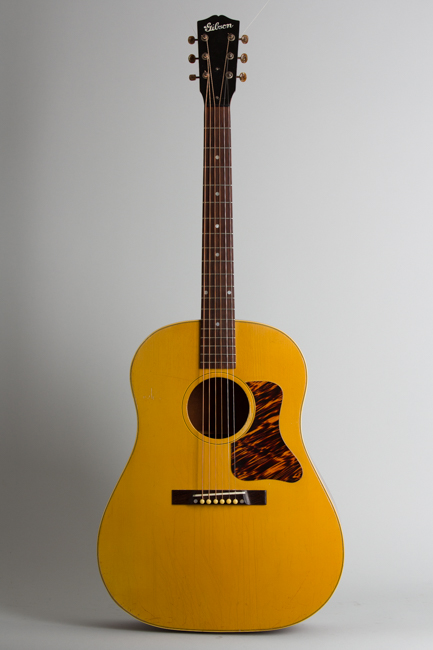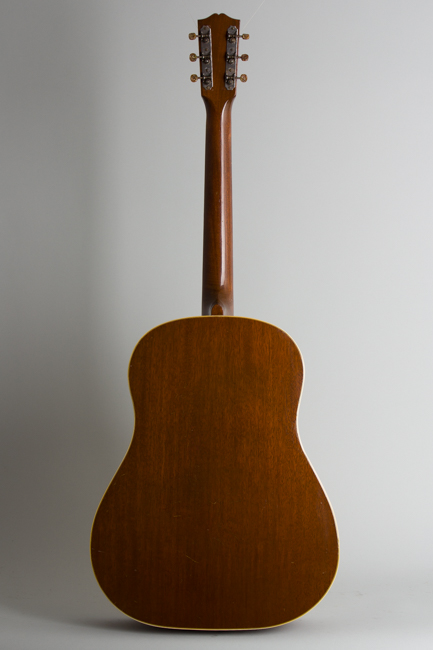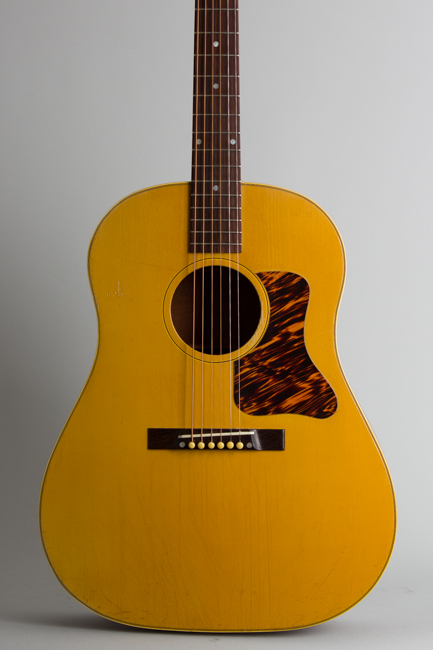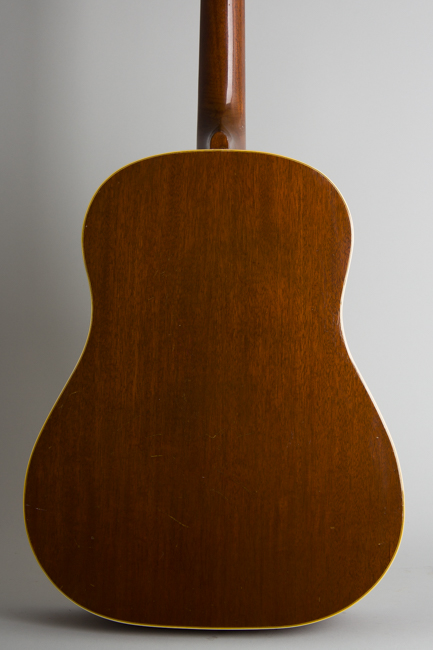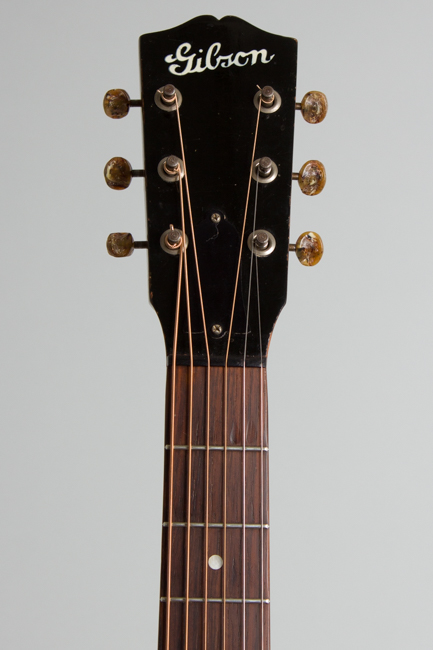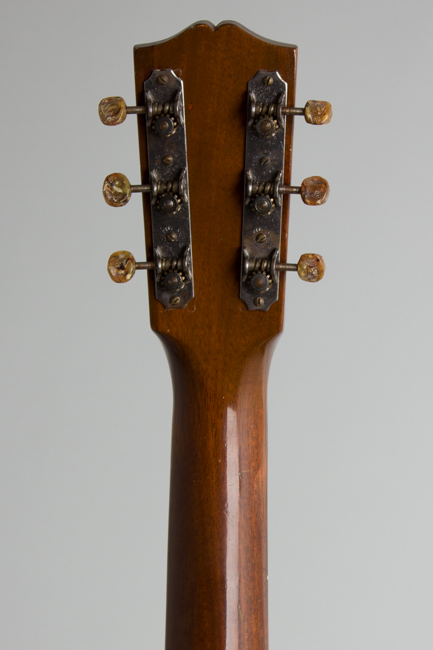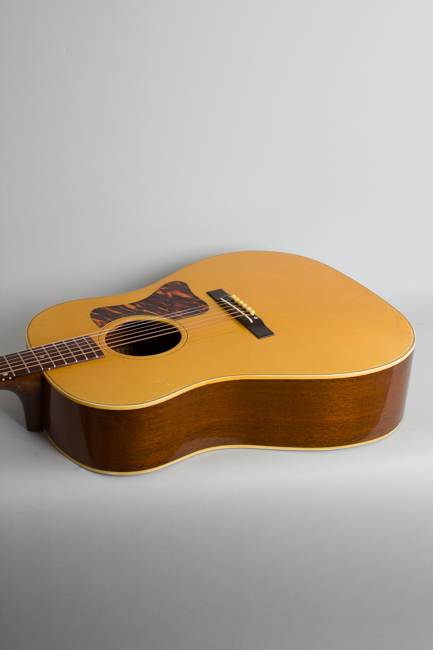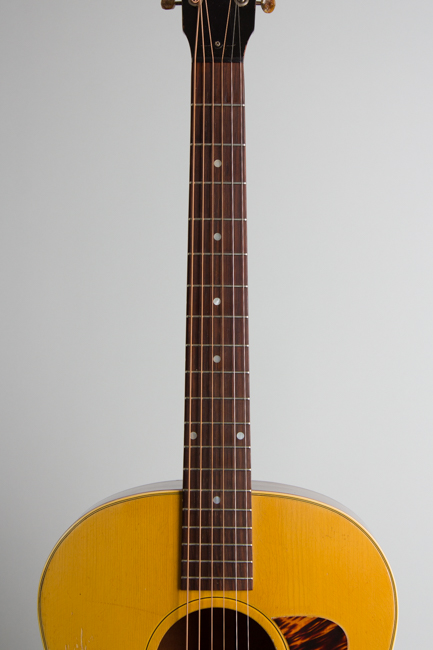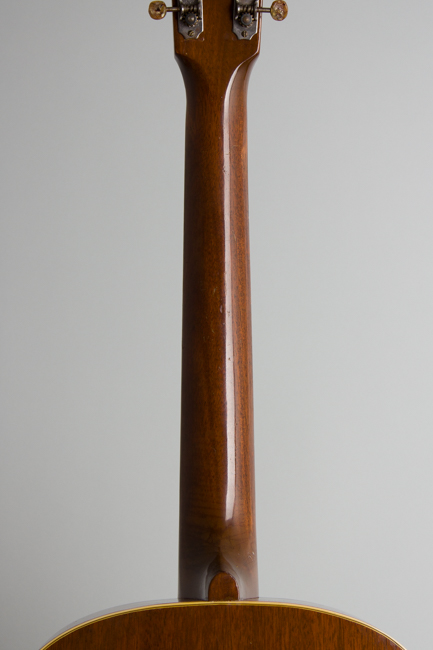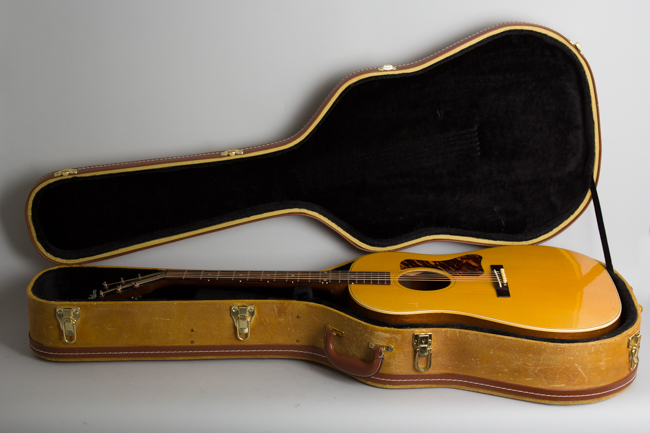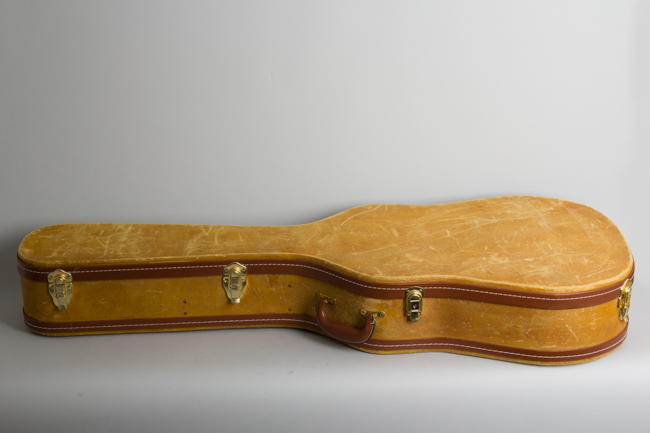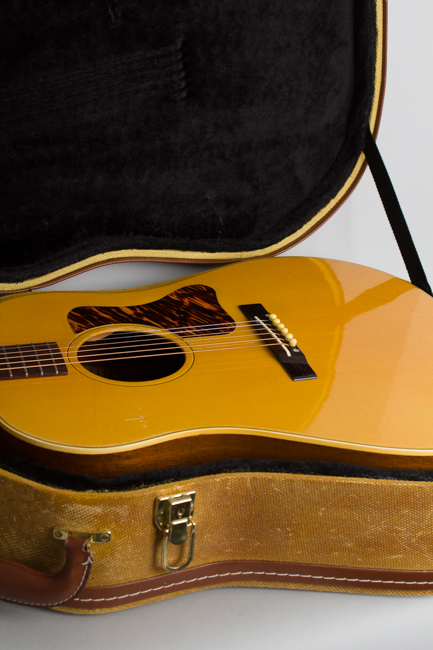Gibson J-35 Flat Top Acoustic Guitar (1941-2)
This item has been sold.
Item # 10944
Prices subject to change without notice.
Gibson J-35 Model Flat Top Acoustic Guitar (1941-2), made in Kalamazoo, Michigan, Blonde lacquer finish, mahogany sides, back and neck; spruce top, rosewood fingerboard, tweed hard shell case.
This is a particularly beautiful and somewhat unusual late example of the J-35, Gibson's "working man's" Jumbo flat-top in the late 1930s and early '40s. Before 1939 the J-35 was only available with a sunburst top finish; after that time most were finished in clear natural. This guitar is neither; it has an opaque blonde lacquer-finished top over natural back and sides. Right around 1940-42 Gibson experimented with this type of finish but never adopted it in a big way; both Epiphone and Gretsch used this look more extensively at the same time. A big advantage over a clear natural finish (for the builder) was that the opaque lacquer covers up any visual flaws in the wood; in this pre/early WWII period when shipments and wood supplies were suddenly unreliable this was an important consideration!
This guitar is difficult to date exactly as the FON (factory order number) on the neck has faded beyond any legibility. Based on the features it was made late in 1941 or early 1942, just before the model was re-designed as the J-45. Besides the unusual top finish, this guitar has more-fancy-than-normal 5-ply binding around the top and 3-ply on the back; most J-35's are single bound. The soundhole ring is the standard austere 3-ply, while the distinctive pickguard is the "firestripe' celluloid characteristic of Gibson in this period. The bridge is a small rectangle of rosewood, with pearl dots on the top covering the reinforcing bolts helping secure it.
The mahogany neck on this guitar has a very comfortable (and surprisingly modern) slim C profile, worlds away from the 1930s heavy V shape used on earlier J-35's that some players find awkward. Other original features include the branded openback Kluson strip tuners with riveted shafts and the mottled-plastic buttons specific to this period, a thin "French" heel and silkscreened white script Gibson logo on the headstock.
The light tapered X-pattern combined with two-tone-bar bracing is quite light, making for a very responsive large-body guitar. These later models tend to be sweeter sounding than Gibson's 1930's Jumbos and the early J-35s, with a smoother tone if a bit less raw power. This is a great-playing and sounding guitar, fully original and a lovely, unusual and very striking example of one of Gibson's best 16" flat-top guitars.
Overall length is 41 in. (104.1 cm.), 16 in. (40.6 cm.) wide at lower bout, and 4 7/8 in. (12.4 cm.) in depth at side, taken at the end block. Scale length is 24 3/4 in. (629 mm.). Width of nut is 1 11/16 in. (43 mm.).
This guitar remains in very nicely preserved, all original condition with some light general wear but no really visible repair. It appears completely crack-free, which is kind of amazing for a lightly-built large body Gibson from this period. The lacquer finish remains nicely original with a moderately checked patina showing some scratches, dings and dents but no major picking wear except an area down to the wood on the lower soundhole rim and a small spot on the top forward of the upper waist. There is scuffing and scratching to the back, mostly into but not through the finish.
The rosewood bridge and small maple bridgeplate remain original, the bridge may have been reglued at some point but if so it was an incredibly neat job. The bridge also may have been re-shaped on top at some point, the contour is a bit unusual but this may simply be another Gibson oddity specific to this guitar. The bone saddle is most likely later or has been re-contoured somewhat. Amazingly the celluloid bridge pins and end pin appear original. The original Kluson tuners have been off and back on but there is no notable widening of the shaft holes. There was a strap button added at the heel that has since been removed and the hole filled.
This is an excellent sounding guitar, smooth and responsive but with more power in reserve than some of these. It does not appear to have had or ever needed a neck reset, and playability is excellent with just some minor wear to the original frets and fingerboard in the first position. We love all vintage J-35's, but this is a really special one, a bit of a mystery guitar and a very singular instrument by any standard. Excellent Condition.
This is a particularly beautiful and somewhat unusual late example of the J-35, Gibson's "working man's" Jumbo flat-top in the late 1930s and early '40s. Before 1939 the J-35 was only available with a sunburst top finish; after that time most were finished in clear natural. This guitar is neither; it has an opaque blonde lacquer-finished top over natural back and sides. Right around 1940-42 Gibson experimented with this type of finish but never adopted it in a big way; both Epiphone and Gretsch used this look more extensively at the same time. A big advantage over a clear natural finish (for the builder) was that the opaque lacquer covers up any visual flaws in the wood; in this pre/early WWII period when shipments and wood supplies were suddenly unreliable this was an important consideration!
This guitar is difficult to date exactly as the FON (factory order number) on the neck has faded beyond any legibility. Based on the features it was made late in 1941 or early 1942, just before the model was re-designed as the J-45. Besides the unusual top finish, this guitar has more-fancy-than-normal 5-ply binding around the top and 3-ply on the back; most J-35's are single bound. The soundhole ring is the standard austere 3-ply, while the distinctive pickguard is the "firestripe' celluloid characteristic of Gibson in this period. The bridge is a small rectangle of rosewood, with pearl dots on the top covering the reinforcing bolts helping secure it.
The mahogany neck on this guitar has a very comfortable (and surprisingly modern) slim C profile, worlds away from the 1930s heavy V shape used on earlier J-35's that some players find awkward. Other original features include the branded openback Kluson strip tuners with riveted shafts and the mottled-plastic buttons specific to this period, a thin "French" heel and silkscreened white script Gibson logo on the headstock.
The light tapered X-pattern combined with two-tone-bar bracing is quite light, making for a very responsive large-body guitar. These later models tend to be sweeter sounding than Gibson's 1930's Jumbos and the early J-35s, with a smoother tone if a bit less raw power. This is a great-playing and sounding guitar, fully original and a lovely, unusual and very striking example of one of Gibson's best 16" flat-top guitars.
Overall length is 41 in. (104.1 cm.), 16 in. (40.6 cm.) wide at lower bout, and 4 7/8 in. (12.4 cm.) in depth at side, taken at the end block. Scale length is 24 3/4 in. (629 mm.). Width of nut is 1 11/16 in. (43 mm.).
This guitar remains in very nicely preserved, all original condition with some light general wear but no really visible repair. It appears completely crack-free, which is kind of amazing for a lightly-built large body Gibson from this period. The lacquer finish remains nicely original with a moderately checked patina showing some scratches, dings and dents but no major picking wear except an area down to the wood on the lower soundhole rim and a small spot on the top forward of the upper waist. There is scuffing and scratching to the back, mostly into but not through the finish.
The rosewood bridge and small maple bridgeplate remain original, the bridge may have been reglued at some point but if so it was an incredibly neat job. The bridge also may have been re-shaped on top at some point, the contour is a bit unusual but this may simply be another Gibson oddity specific to this guitar. The bone saddle is most likely later or has been re-contoured somewhat. Amazingly the celluloid bridge pins and end pin appear original. The original Kluson tuners have been off and back on but there is no notable widening of the shaft holes. There was a strap button added at the heel that has since been removed and the hole filled.
This is an excellent sounding guitar, smooth and responsive but with more power in reserve than some of these. It does not appear to have had or ever needed a neck reset, and playability is excellent with just some minor wear to the original frets and fingerboard in the first position. We love all vintage J-35's, but this is a really special one, a bit of a mystery guitar and a very singular instrument by any standard. Excellent Condition.
